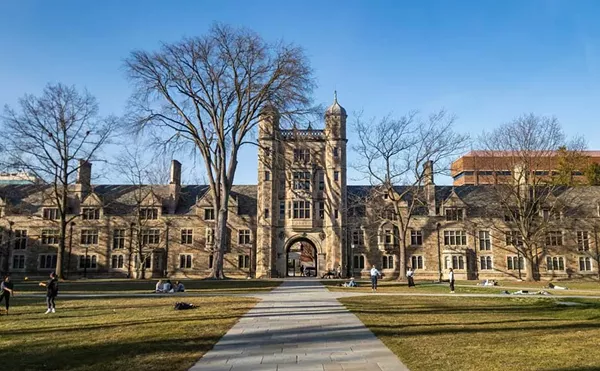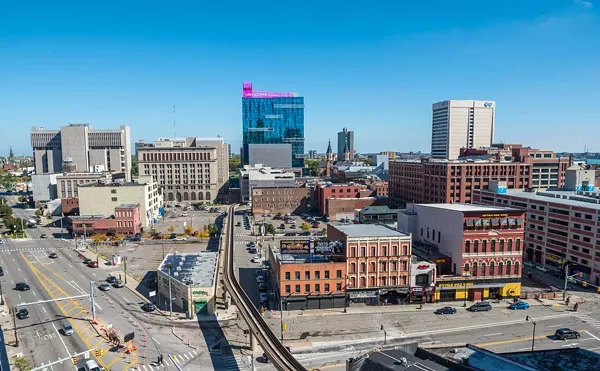Warning: This column may give you nightmares.
And it damn well should.
OK, here goes: Did you know that every day, up to 540,000 barrels of oil and propane are pumped through two steel pipes lying at the bottom of the Straits of Mackinac?
That's roughly the line between Lakes Huron and Michigan. Those pipes, which are protected by nothing, snake on for 4.5 miles underwater, as much as 270 feet below the surface.
Down there, 23 million gallons of pressurized oil is roaring through them, every day. Nobody would dispute that there is no more important resource in this part of the world than the Great Lakes.
They hold 84 percent of all the fresh water in North America. You don't even want to think about what might happen if those pipes were to rupture, and millions of gallons of oil were pumped into the lakes before anyone could do anything about it.
Mess the Great Lakes up, and you're looking at the mother of all environmental disasters, and the distinct possibility that life in these parts would no longer be nearly as worth living.
Now think about this: Those pipelines, which are owned and operated by a Canadian firm called Enbridge, were on the bottom of the lakes, carrying all that oil ... the day President Obama was born.
In fact, they've been there for 62 years. If they were human, they would be eligible for Social Security. So far, they haven't cracked or corroded enough to rupture. But ... all it would take is once.
How safe are they?
We have no idea ... because the company refuses to tell us. Enbridge says they're safe. They say they're inspected mechanically and tested for signs of corrosion, inside and out.
But they won't share the results of those tests. Not with us, and not fully even with the state. Earlier this month, the Michigan Petroleum Pipeline Task Force released its report on the pipeline.
The task force was chaired by state Attorney General Bill Schuette, who never misses a chance to pander to the far right, and Dan Wyant, who is Rick Snyder's director of the Michigan Department of Environmental Quality. No flaming radicals here, but even they seemed plainly irked by Enbridge.
While the task force's suggested reforms were tepid at best, they did call for the legislature to require Enbridge to disclose its safety-inspection records. (Lots of luck with that, given the nature of our elected bozos and the power of company lobbyists.)
Schuette did note that building a pipeline under the straits would never be allowed today. He called for Enbridge to replace it, after what the attorney general said would be a "short duration."
But guess what: Enbridge isn't going to do that unless forced to. Finding a replacement would cost a lot, and the company wants us to accept its assurances that the pipeline is safe.
We shouldn't accept that as good enough from anyone — but especially not Enbridge. Now for the part that should really ruin your sleep: Five years ago this week, on July 25, 2010, another Enbridge pipeline — one that was only 40 years or so old — ruptured in the Kalamazoo River, near Marshall, Michigan.
This sent more than a million gallons of heavy crude oil into the water. This was on a Sunday evening. It was 18 hours before the company figured out what was happening. Alarms did go off when the pipeline ruptured — but idiot workers thought it meant the pipeline was blocked — so they increased the pressure, sending even more crude into the river. The mess took four years to clean up.
Twenty-five miles of the river was heavily contaminated. Thirty-five miles were closed to recreational boating, etc., for almost two years. The company first said the cleanup would cost $5 million.
But the total bill was well over $1.2 billion. The cleanup will never really be complete; there will always be some residual oil.
What caused the pipe to break? According to the National Transportation Safety Board (NTSB) study and report, "corrosion fatigue" in the pipes, the same thing people most worry about when it comes to the pipeline beneath the straits.
The head of the NTSB at the time heavily criticized Enbridge's incompetent handling of the disaster, comparing it to the Keystone Kops. Enbridge finally agreed to pay Michigan a $75 million fine.
If anything like that happened to the pipeline beneath the straits, it would make the Kalamazoo River disaster look like a little ink spilled in the bathtub. True, the straits pipeline doesn't carry the heavy crude and tar sands oil that the Kalamazoo one did.
But how would you clean up two lakes polluted by who knows how many million gallons if the pipeline were to break?
You couldn't. The government needs to step up to Enbridge and give them an ultimatum and a timetable for closing the pipeline.
Otherwise, well — there are those who think this country puts profits before people, maybe before life itself. Waiting for the lakes to be destroyed would be a pretty conclusive way to prove it.
The Chattanooga shooter
For days after Muhammad Abdulazeez murdered four U.S. Marines and one Navy serviceman earlier this month, investigators tried to figure out whether it was a case of Islamic terrorism striking deep in the heartland, etc.
Well, the killer does seem to have read Muslim extremist blah-blah online, which doesn't prove anything. Lee Harvey Oswald defected to the Soviet Union for a while and called himself a Marxist, but certainly didn't kill John F. Kennedy for the Kremlin.
But there's one often-overlooked thread connecting the Tennessee killer to most famous American assassins, and it has nothing to do with Islam.
His age.
Abdulazeez, who is probably not frolicking around with any legendary virgins in paradise, was 24 when he killed those people.
Oswald was also 24. So was Sirhan Sirhan, when he killed Bobby Kennedy, and James Eagan Holmes, who murdered 12 people three years ago in that movie theater in Aurora, Colorado.
Mark David Chapman, who killed John Lennon, was 25, as was John Hinckley Jr., who badly wounded Ronald Reagan. The guy who shot Congresswoman Gabrielle Giffords was 22, as was Arthur Bremer, who shot George Wallace back in 1972.
The list goes on and on, and the lesson is clear: White men in their early 20s who are losers and have guns are baaaaad news.
But then, your mama probably told you that.
Jack Lessenberry is head of the journalism program at Wayne State University and the senior political analyst for Michigan Public Radio.






